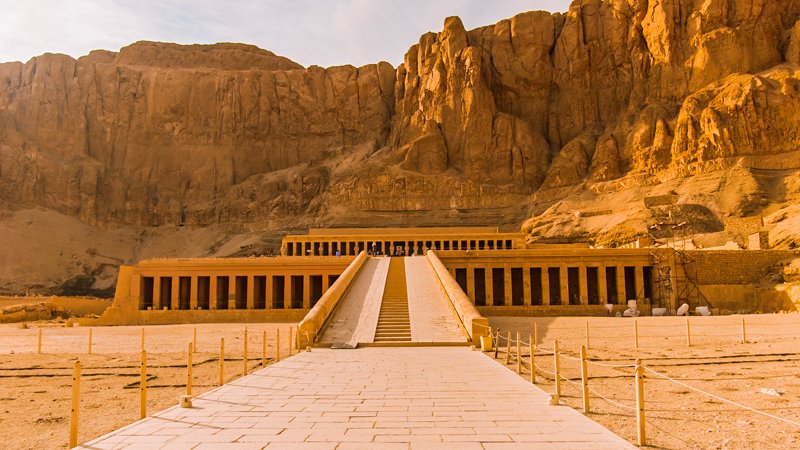Nestled at the base of towering cliffs in Deir el-Bahari, the Temple of Hatshepsut is one of Egypt’s most iconic architectural masterpieces. Built by and dedicated to one of Egypt’s few female pharaohs, Queen Hatshepsut, the temple stands as a symbol of her extraordinary reign. As you walk through its grand colonnades, you’re stepping into a world where art, politics, and religion intertwined in fascinating ways. Travelers who visit Luxor cannot miss this breathtaking monument, which showcases the heights of ancient Egyptian architectural prowess and innovation. This unique site offers visitors a glimpse into the grandeur of Egypt’s 18th Dynasty, blending seamlessly with its rugged natural surroundings.
Historical Background of Queen Hatshepsut
Queen Hatshepsut was not only a significant figure in ancient Egyptian history, but she was also a revolutionary ruler. Ascending to the throne in a predominantly male-driven society, she reigned from approximately 1479 to 1458 BCE, asserting herself as one of the most successful pharaohs of the New Kingdom. Her reign was characterized by economic prosperity, military success, and an unprecedented focus on building and restoration projects. The Temple of Hatshepsut, or Djeser-Djeseru (“Holy of Holies”), is the most enduring symbol of her reign. Travelers interested in the rich stories of Egypt’s past will find Hatshepsut’s story particularly compelling—her rise to power, the cultural significance of her reign, and the controversies surrounding her legacy.
Architectural Marvel of the Temple
The Temple of Hatshepsut is often considered an architectural masterpiece of ancient Egypt. Designed by the royal architect Senenmut, this mortuary temple blends perfectly with its environment, as the terraces rise in harmony with the cliffs behind them. The symmetry and scale of the temple reflect the grandeur of Hatshepsut’s vision. It consists of three large terraces connected by ramps, each adorned with colonnades, statues, and reliefs depicting significant events from Hatshepsut’s reign. Travelers visiting the temple are immediately struck by the imposing yet elegant design, which showcases the advanced engineering skills of the ancient Egyptians. The temple’s alignment with the winter solstice adds another layer of wonder, as the sun’s rays perfectly illuminate the sanctuary during this celestial event.
Religious Significance of the Temple
Hatshepsut’s temple was not just an architectural feat; it was also a sacred site dedicated to the gods Amun-Ra, Hathor, and Anubis. As a mortuary temple, it served as a place of worship for the deceased queen and a center for posthumous rituals. Visitors will notice that religious iconography and symbolism are deeply embedded in every corner of the structure, from the reliefs portraying the queen in the divine company of gods to the chapels dedicated to deities important to her rule. For those with a keen interest in ancient Egyptian religion and mythology, the Temple of Hatshepsut provides a rich tapestry of divine interactions, offerings, and sacred spaces.
The Journey to the Afterlife
The temple’s reliefs and inscriptions vividly depict Hatshepsut’s divine birth and her journey to the afterlife. These scenes are vital in understanding the ancient Egyptians’ belief system regarding kingship, divinity, and the afterlife. For travelers interested in the spiritual aspects of ancient Egyptian culture, the temple’s art provides profound insights. One of the most famous reliefs is the depiction of Hatshepsut’s divine conception, where Amun-Ra, the sun god, is said to have fathered her, legitimizing her rule. The emphasis on Hatshepsut’s divine connection underscores the idea that pharaohs were not just earthly rulers but also deities in human form, a concept that resonated deeply with the ancient Egyptians.
Restoration and Preservation Efforts
Throughout the centuries, the Temple of Hatshepsut has faced the ravages of time, natural erosion, and human intervention. In the modern era, extensive restoration efforts have been undertaken to preserve this incredible monument for future generations. Ongoing preservation work ensures that the temple remains a must-see destination for travelers to Egypt. Visitors today can appreciate the temple’s stunning beauty while also understanding the importance of its preservation in maintaining Egypt’s cultural heritage. The Polish-Egyptian Archaeological Mission has played a crucial role in restoring parts of the temple, meticulously reconstructing damaged areas to bring back the temple’s original splendor.
The Temple’s Connection to the Valley of the Kings
Located near the famous Valley of the Kings, the Temple of Hatshepsut often serves as a gateway for travelers exploring the many tombs of Egypt’s greatest pharaohs. The proximity of the temple to the burial grounds of the New Kingdom rulers underscores its importance in the mortuary landscape of ancient Thebes. For those touring the area, the temple offers a comprehensive look at how death, burial, and the afterlife were central to ancient Egyptian beliefs. While Hatshepsut herself was not buried here (her tomb lies in the Valley of the Kings), her temple’s function as a place of worship and commemoration highlights the intricate relationship between life, death, and eternity in Egyptian culture.
Notable Art and Reliefs
The temple’s walls are adorned with some of the most intricate and well-preserved reliefs from ancient Egypt. These artworks not only depict the grandeur of Hatshepsut’s reign but also detail important expeditions, such as the famous voyage to the Land of Punt. This journey, which brought back valuable resources like incense and myrrh, is one of the most celebrated events of Hatshepsut’s rule and is commemorated in vivid relief on the temple’s walls. For art enthusiasts and history buffs, these detailed carvings provide an unparalleled glimpse into the daily life, trade, and religious practices of the time.
The Legacy of Hatshepsut
Hatshepsut’s legacy is a complicated and contested one. After her death, many of her monuments and images were defaced or erased by her successors, likely due to her unprecedented role as a female ruler. However, her mortuary temple has stood the test of time, ensuring that her reign is remembered for its prosperity, monumental achievements, and lasting impact on Egyptian history. Visitors to the Temple of Hatshepsut will come away with a deeper understanding of her contributions to Egypt’s golden age, as well as the complexities surrounding her place in history. For modern travelers, the temple stands as a testament to Hatshepsut’s resilience and her undeniable influence.
How to Visit the Temple of Hatshepsut
For those planning a trip to Egypt, the Temple of Hatshepsut is easily accessible from Luxor, making it a perfect day trip. Most guided tours of the West Bank include a visit to this temple, along with other notable sites such as the Valley of the Kings and the Colossi of Memnon. Travelers should plan to visit early in the morning or late in the afternoon to avoid the midday heat and take advantage of the stunning light that bathes the temple in golden hues. The site is open daily, and entry tickets can be purchased on-site or through tour operators. For a truly immersive experience, visitors should consider hiring an Egyptologist guide who can provide in-depth insights into the temple’s history, art, and significance.
Conclusion: A Must-Visit for Travelers to Egypt
The Temple of Hatshepsut is more than just a historical monument; it is a symbol of power, innovation, and religious devotion that has stood for over three millennia. For travelers looking to explore the rich history of ancient Egypt, this temple offers an unforgettable experience. Its majestic architecture, fascinating history, and stunning artwork make it a must-visit destination for anyone traveling to Egypt. Whether you’re a history enthusiast, an art lover, or simply a curious traveler, the Temple of Hatshepsut promises to be one of the highlights of your Egyptian adventure.

